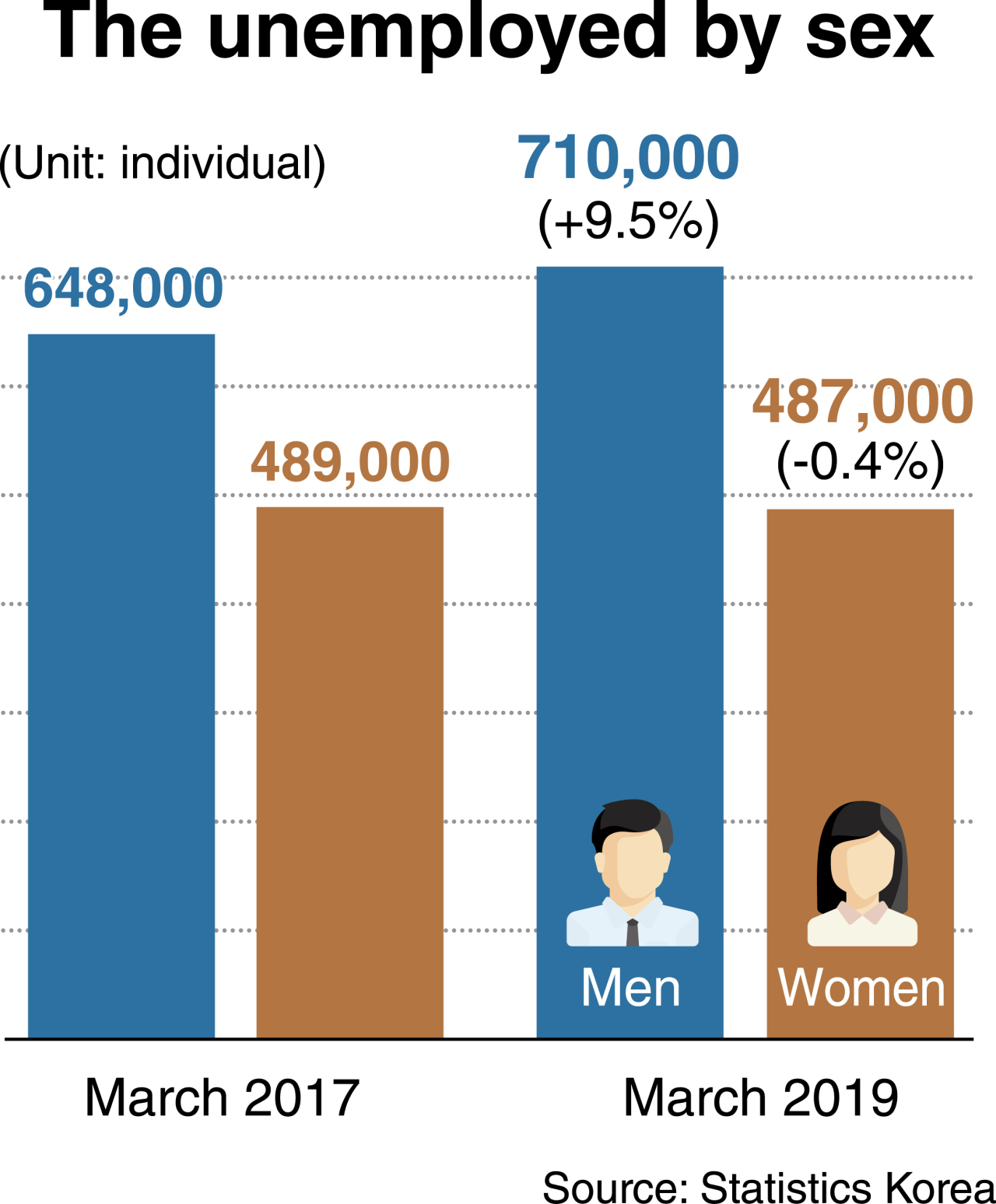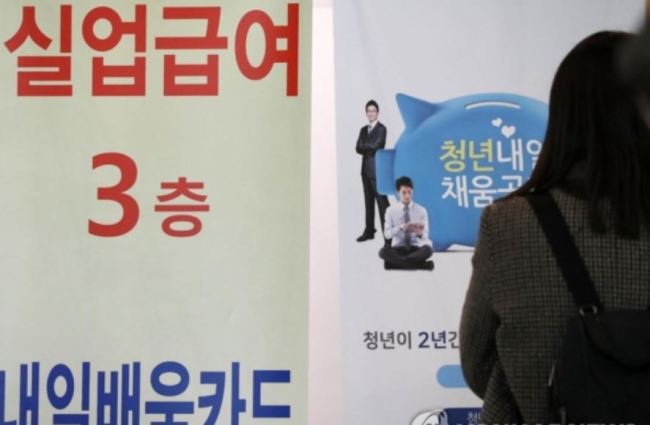[News Focus] Number of jobless men grows by 62,000 in 2 years
By Kim Yon-sePublished : April 30, 2019 - 16:42
SEJONG -- Unemployment is among the major social issues that President Moon Jae-in set out to resolve when he took office in May 2017.
Despite Moon’s continual pledges to prioritize job creation throughout his term, South Korea’s employment numbers have remained lackluster compared with those seen in other members of the Organization for Economic Cooperation and Development.
Whereas 27 of the 36 OECD member nations recorded on-year declines in unemployment in 2018, Korea saw its jobless rate rise by 0.1 percentage point to 3.8 percent last year.
As of March 2019, Korea’s jobless rate was 4.3 percent, as compared with 4.1 percent posted in March 2017. This 0.2 percentage point increase may reflect the performance of the Moon government over the past two years.
Despite Moon’s continual pledges to prioritize job creation throughout his term, South Korea’s employment numbers have remained lackluster compared with those seen in other members of the Organization for Economic Cooperation and Development.
Whereas 27 of the 36 OECD member nations recorded on-year declines in unemployment in 2018, Korea saw its jobless rate rise by 0.1 percentage point to 3.8 percent last year.
As of March 2019, Korea’s jobless rate was 4.3 percent, as compared with 4.1 percent posted in March 2017. This 0.2 percentage point increase may reflect the performance of the Moon government over the past two years.

The situation is especially bleak for men. Data from Statistics Korea show surges both in the jobless rate for men and in the number of unemployed men since 2017.
The number of unemployed people, both men and women, increased 5.2 percent during the March 2017 through March 2019 period -- from almost 1.14 million to almost 1.2 million.
But for men in particular, the figures rose even more sharply, from 648,000 to 710,000. That represents an increase of 62,000, or 9.5 percent. The jobless rate among men also rose, from 4.1 percent to 4.4 percent.
In contrast, the number of unemployed women inched down from 489,000 to 487,000. The unemployment rate for women fell 0.1 percentage point to 4.1 percent.
When compared with the situation five years ago, the current unemployment figures for Korean men are even more alarming. The number of men out of work -- 710,000 as of last month -- has grown 16.3 percent from the 610,000 recorded in March 2014.
“The recent rise in the number of jobless men could be attributable to higher unemployment among men in their 40s and 50s,” said a private research fellow residing in Sejong City.
The number of men in their 40s and 50s who were out of work grew from 95,000 and 87,000 -- by 9.4 percent and 37.9 percent -- to 104,000 and 120,000 over the corresponding period.
“Given their status as heads of households, this trend is more critical than the high unemployment rate among younger people,” said the researcher.
He also said the government jobs created for elderly people had probably benefited women over the age of 60 more than any other demographic.
While the number of unemployed women aged 60 or over remained stable at 44,000 as of March 2019, the number of unemployed men in the same age group was 104,000.
A former senior researcher from the Korea Research Institute for Vocational Education and Training cited another worrisome statistic: The number of new hires in 2018 was the lowest in nine years.
He was quoted by a news provider as saying “the number of new hires last year stood at only one-third of the figure in 2017.” He called for the government to take countermeasures to raise employment levels among middle-aged men, stressing that “they are in charge of households.”
A number of market insiders shared the view that the drastic hike in the statutory minimum wage undermined the labor market. They say it dealt a severe blow to the wholesale, retail, lodging and food service sectors.

Likewise, the OECD has said the sharp hike in Korea’s minimum wage could hinder employment and the growth of its gross domestic product.
The Paris-based international organization also predicted that Korea could see its yearly jobless rate hit the 4 percent mark in 2019, for the first time in 18 years.
Meanwhile, a recent TV documentary cited data from a private research institute suggesting that the “real” 2018 unemployment rate in Korea might be as high as 11.8 percent -- far higher than the 3.8 percent calculated by the government.
Real unemployment includes temporary employees who work fewer than 36 hours a week and want to change jobs, as well as those out of work for certain periods despite being eligible to work.
Moon begins the remaining 60 percent of his five-year tenure next week. Surveys show that a large percentage of the country has identified the president’s performance on the economy as a major reason for not supporting him.
By Kim Yon-se (kys@heraldcorp.com)






![[From the Scene] Monks, Buddhists hail return of remains of Buddhas](http://res.heraldm.com/phpwas/restmb_idxmake.php?idx=644&simg=/content/image/2024/04/19/20240419050617_0.jpg&u=20240419175937)







![[From the Scene] Monks, Buddhists hail return of remains of Buddhas](http://res.heraldm.com/phpwas/restmb_idxmake.php?idx=652&simg=/content/image/2024/04/19/20240419050617_0.jpg&u=20240419175937)

![[KH Explains] Hyundai's full hybrid edge to pay off amid slow transition to pure EVs](http://res.heraldm.com/phpwas/restmb_idxmake.php?idx=652&simg=/content/image/2024/04/18/20240418050645_0.jpg&u=20240419100350)

![[Today’s K-pop] Illit drops debut single remix](http://res.heraldm.com/phpwas/restmb_idxmake.php?idx=642&simg=/content/image/2024/04/19/20240419050612_0.jpg&u=)